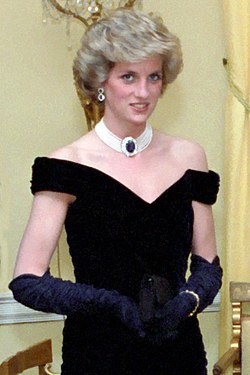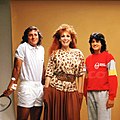
Fashion of the 1980s was characterized by a rejection of psychedelic colored, ornate fashions of the 1970s. Punk fashion began as a reaction against both the hippie movement of the past decades and the materialist values of the current decade. [2] The first half of the decade was relatively tame in comparison to the second half, which was when apparel became very bright and vivid in appearance.
Contents
- Women's fashion
- Early 1980s (1980–1983)
- Mid-1980s (1984–1986)
- Late 1980s (1987–1989)
- Men's fashion
- Early 1980s (1980–1983) 2
- Mid-1980s (1984–1986) 2
- Late 1980s (1987–1989) 2
- Unisex accessories
- Subcultures of the 1980s
- Heavy metal
- Punk
- New Romantic
- Rockabilly
- Rude boys and skinheads
- Casuals
- Skaters
- Rap and hip-hop
- Preppy
- Hairstyles
- Women's hairstyles
- Men's hairstyles
- Image gallery
- See also
- References
- Further reading
- External links
One of the features of fashion in the second half of the 1980s was the interest in alternative forms. In the 1980s, alternative trends became widespread. [3] This phenomenon has been associated with such phenomena as street style, punk and post-punk. [4]
During the 1980s, shoulder pads, which also inspired "power dressing," became common among the growing number of career-driven women. [5] [6]
The women's shoe that typified the decade was the closed pump with a sharply tapered or pointed toe, first revived at the end of the seventies. [7] These were similar to pumps worn during the second half of the 1950s and came in a variety of heel heights and tapered heel shapes, cone-shaped to spike to stiletto, almost always underslung. One of the ways to update an older outfit during the 1980s was to wear it with a pair of eighties pumps. [8]
Hair in the 1980s was typically big, curly, bouffant and heavily styled. Television shows such as Dynasty helped popularize the high volume bouffant and glamorous image associated with it. [9] [10] Women in the 1980s wore bright, heavy makeup. Everyday fashion in the 1980s consisted of light-colored lips, dark and thick eyelashes, and pink or red rouge (otherwise known as blush). [11] [12]
Some of the top fashion models of the 1980s were Brooke Shields, Christie Brinkley, Inès de La Fressange, Jerry Hall, Elle MacPherson, Isabella Rossellini, Carol Alt, Gia Carangi, Paulina Porizkova, Kim Alexis, Kelly Emberg, Janice Dickinson, Kelly LeBrock, Joan Severance, Yasmin Le Bon, Renée Simonsen and Tatjana Patitz. [13]







































